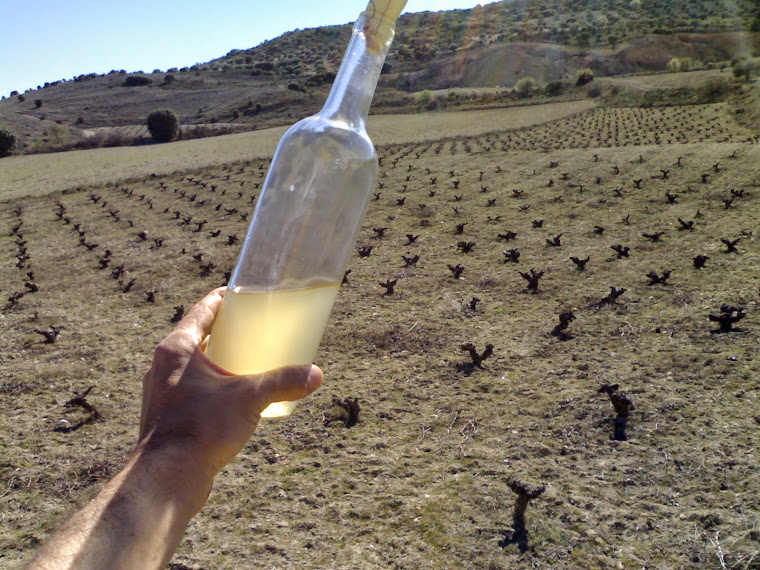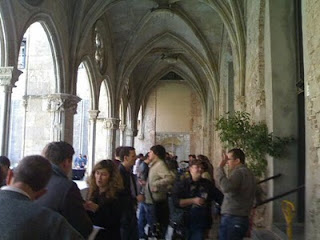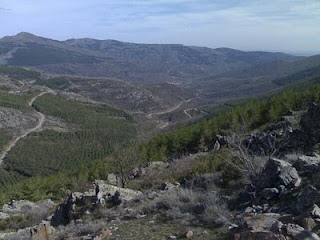This was the second stop on the Catavino.es On Tour series of tastings planned for all over Spain. It was held in a nice place called Arte & Vino in collaboration with Cristina Prat from Ruta del Vino de Ribera del Duero.
The ceiling decor at Arte y Vino
Again, I let my arm be twisted by blogger Ignacio Segovia who again kindly offered to pick me up, drive there and back and then drop me off at home. This time we were joined by TV producer, specialized in wine, Eduardo Benitez.
Just like in Utiel, 2 weeks ago, there was an impressive array of bodegas offering us their wares, including some that I suspect I could never afford to actually buy! See the links below for a comprehensive list of wineries and wines and tasting notes.
The tasting table
Just like in Utiel, and still not being an experienced taster, what can I say? I liked all of them! They were all based on Tempranillo, so I suppose that makes me a little biased as that’s what I work with and am used to drinking! I’ll leave the detailed tasting notes and opinions to the experts, which you can read if you follow the links below.
There were only four of us, guided by the owner's daughter beatriz: Juan manuale, Eduardo, Ignacio and myself. In such company I didn’t bother taking many photos of the actual caverns themselves, just of the bloggers themselves in action. I figured they'd be able to take much better photos and videos than me, so I just relaxed and enjoyed (and took photos of them taking photos!)
Juan Manuel Gozalbes (Catavino) taking a photo
Ignacio Segovia (vendervino.com) taking a photo
Beatriz, the owner’s daughter, who led us through the caverns, told us that some of the passageways date back to the 12th century!!! Ansolutely incredible!
The links:
1. Catavino: (list of and links to all 13 of the bodegas present) (in Spanish)
2. WineBookClub (in English)
3. Vinus.tv (video of underground caverns)
4. Vendervino.com (in Spanish)
5. Ruta del Vino de Ribera del Duero
Other links mentioning this tasting (mostly in Spanish):
1. http://www.abritealoinesperado.com.ar/2010/04/14/catavino-es-on-tour-ribera-del-duero/
2. http://catavino.net/es/evento/la-segunda-etapa-de-la-aventura-catavino-es-on-tour-aranda-del-duero/
3. http://www.blogdevino.com/2010/04/24/ruta-del-vino-ribera-del-duero/
4. http://websvino.blogspot.com/2010/04/catavinoes-on-tour-cap-2-ribera-del.html
5. http://www.verema.com/blog/cepabodegayvino/733354-catavino-es-on-tour
6. http://www.tenedoresyguitarras.com/index.php/2010/04/bodegas-y-bloggers-en-la-ribera-del-duero/
7. http://twitter.com/#search?q=%23CVtour
8. http://www.adegga.com/events/50-catavinoes-tour?page=2
9. http://www.mundovino.net/videos/bodega-historica-de-el-lagar-de-isilla
10. http://www.vinustv.es/2010/04/22/bodega-historica-de-el-lagar-de-isilla/
11. http://www.ubervu.com/conversations/catavino.net/es/cata-virtual/catavino-es-on-tour-cap-2-ribera-del-duero/
12. http://www.facebook.com/album.php?aid=161229&id=238263533875&ref=mf
13. http://vinosambiz.blogspot.com/
14. http://vinosambiz.blogspot.com/2010/04/another-tasting-for-bloggers-in-aranda.html
15. http://www.diariodelaribera.org/cultura/629-ruta-del-vino-organiza-una-cata-20.html
16. http://www.vendervino.com/evento-en-aranda-el-vino-y-su-alma/
17. http://www.vinustv.es/2010/04/28/catavino-on-tour-ribera-del-duero/


























